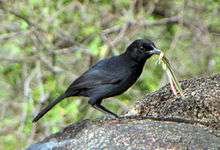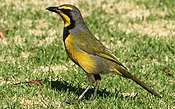Bushshrike
The bushshrikes are smallish passerine birds. They were formerly classed with the true shrikes in the family Laniidae, but are now considered sufficiently distinctive to be separated from that group as the family Malaconotidae.
| Bushshrikes | |
|---|---|
_(1).jpg) | |
| A yellow-crowned gonolek (Laniarius barbarus) in Gambia | |
| Scientific classification | |
| Kingdom: | Animalia |
| Phylum: | Chordata |
| Class: | Aves |
| Order: | Passeriformes |
| Superfamily: | Corvoidea |
| Family: | Malaconotidae Swainson, 1824 |
| Genera | |
|
Nilaus | |
This is an African group of species which are found in scrub or open woodland. They are similar in habits to shrikes, hunting insects and other small prey from a perch on a bush. Although similar in build to the shrikes, these tend to be either colourful species or largely black; some species are quite secretive.
Some bushshrikes have flamboyant displays. The male puffbacks puff out the loose feathers on their rump and lower back, to look almost ball-like.
These are mainly insectivorous forest or scrub birds. Up to four eggs are laid in a cup nest in a tree.
Taxonomy
Bock has posited that the family name Malaconotidae was first used by William John Swainson in 1824, however this is disputed by Storrs Olson, who reports that Swainson used the term Malaconoti as a non-defining plural, and placed the genus within the Thamnophilinae within the shrike family Laniidae.[1] Peters regarded the group as a subfamily, Malaconotinae, of the shrikes. In 1971, the group was raised to family status, with their resemblance to typical shrikes considered to be more a result of convergent evolution.[2]
Bushshrikes, helmetshrikes (Prionopidae), ioras (Aegithinidae), vangas (Vangidae) and the Australian butcherbirds, magpies and currawongs (Cracticidae) and woodswallows (Artamidae) are part of a large group of shrike-like birds distributed from Africa to Australia, which have been defined as the superfamily Malaconotoidea by Cacraft and colleagues in 2004.[3] Previously, bushshrikes and helmetshrikes have been considered part of the Old World shrike family, Laniidae, based on shared characteristics including a hooked bill.[4] However, analysis of behavioral and molecular characteristics places Malaconotidae closer to Platysteiridae and Vangidae, suggesting that the birds of the family Laniidae are only distant relatives.[5]
An intron-comparison study by Fuchs et al. in 2004 provided strong support for the monophyly of the Malaconotidae, but the relationships between the genera of the family remain unclear.[4] The genus Nilaus is morphologically more similar to Prionopidae than the rest of the bushshrike family is,[5] but the results presented by Fuchs et al. place it within Malaconotidae. This placement is supported by DNA/DNA hybridization data as well as studies of hind limb musculature.[6] The genus Dryoscopus consists of six small species with similar coloring, which may be closely related to birds of the genus Tchagra.[4] The genus Malaconotus consists of six species which have been traditionally believed to be closely related to Telophorus due to similar coloration, but new analyses suggest a close relationship between Malaconotus and Dryoscopus and Tchagra.[4] Strong evidence exists for the monophyly of the genus Laniarius, and Fuchs et al. suggest its closest relatives are the genera Telophorous and Rhodophoneus, but the exact relationships are unclear.[4]
Description
Bushshrikes are small to medium-sized passerines, with short, rounded wings and strong legs and feet. Plumage is typically black, grey, and brown, with some yellow and green. Some bush shrikes have red undersides or red throat-patches.[7]
Distribution and habitat
Bushshrikes typically inhabit forest margins or patches of bush in savannah.[2] Some species have been known to inhabit coffee plantations.[8]
Behavior

Bushshrike diets consist mainly of large insects, but occasionally may include wild fruits and berries[7] and sometimes rodents.[4] They catch their prey by gleaning among tree foliage.[2]
Their nests are generally small and neat, and they lay clutches of 2–3 eggs.[2]
Bushshrikes have distinctive harsh or guttural calls,[7][8] which may be sung as duets. Male and female birds are able to learn songs of similar complexity, and both sexes have similarly-sized repertoire.[9] Songs may be sung to indicate territory or as part of courtship. A 1992 study of the calls of Laniarius funebris found that a male's likelihood of singing a mating song was correlated with his mate's estradiol levels, rather than his own testosterone levels, suggesting that behavioral cues between a mating pair, rather than hormone levels, are most important in triggering mating songs.[10]
List of species in taxonomic order
| Image | Genus | Living Species |
|---|---|---|
.jpg) | Nilaus Swainson, 1827 |
|
_(Northern_Puffback)_-_(male)%2C_Mole_National_Park%2C_Ghana%2C_crop.jpg) | Dryoscopus F. Boie, 1826 – puffbacks |
|
_(cropped).jpg) | Bocagia Shelley, 1894 |
|
 | Tchagra Lesson, 1831 – tchagras |
|
.jpg) | Laniarius Vieillot, 1816 – boubous and gonoleks |
|
 | Rhodophoneus Heuglin, 1871 – rosy-patched bushshrike |
|
.jpg) | Chlorophoneus Cabanis, 1850 |
|
 | Telophorus Swainson, 1832 |
|
_in_tree.jpg) | Malaconotus Swainson, 1824 |
|
References
- Olson, Storrs L. (1995). "Review of History and Nomenclature of Avian Family-Group Names. Bulletin of the American Museum of Natural History, Volume 222". The Auk. 112 (2): 539–46. doi:10.2307/4088759.
- Lovegrove, Roger (2010). Shrikes. Helm Identification Guides. A&C Black. p. 11. ISBN 1408135051.
- Cracraft, Joel, Barker F. Keith, Braun, Michael, Harshman, John, Dyke, Gareth J., Feinstein, Julie, Stanley, Scott, Cibois, Alice, Schikler, Peter, Beresford, Pamela, García-Moreno, Jaime, Sorenson, Michael D., Yuri, Tamaki, Mindell, David P. (2004). "Phylogenetic relationships among modern birds (Neornithes): toward an avian tree of life". In Cracraft J, Donoghue MJ (eds.). Assembling the tree of life. New York, New York: Oxford University Press. pp. 468–89. ISBN 0-19-517234-5.
- Fuchs, Jérôme; Bowie, Rauri C.K.; Fjeldsa, Jon; Pasquet, Eric (2004). "Phylogenetic relationships of the African bush-shrikes and helmet-shrikes (Passeriformes: Malaconotidae)". Molecular Phylogenetics and Evolution. 33 (2): 428–439. doi:10.1016/j.ympev.2004.06.014. PMID 15336676.
- Harris, Tony (2000). Shrikes & Bush-shrikes: Including wood-shrikes, helmet-shrikes, flycatcher-shrikes, philentomas, batises and wattle-eyes. A&C Black.
- Sibley, C.G. et Ahlquist, J.E. (1990). Phylogeny and Classification of Birds: A Study in Molecular Evolution. New Haven, CT: Yale University Press.CS1 maint: uses authors parameter (link)
- Stuart, Chris; Stuart, Tilde (1999). Birds of Africa. Cambridge: MIT Press. ISBN 0-262-19430-9.
- Ryan, P. G.; Sinclair, I.; Cohen, C.; Mills, M. S. L.; Spottiswoode, C.N.; Cassidy, R. (2004). "The conservation status and vocalizations of threatened birds from the scarp forests of the Western Angola Endemic Bird Area". Bird Conservation International. 14: 247–260. doi:10.1017/S0959270904000322.
- Gahr, M.; Sonnenschein, E.; Wickler, W. (1998). "Sex Difference in the Size of the Neural Song Control Regions in a Dueting Songbird with Similar Song Repertoire Size of Males and Females". The Journal of Neuroscience. 18 (3): 1124–1131.
- Schwabl, Hubert et Sonnenschein, Edith (1992). "Antiphonal duetting and sex hormones in the tropical bush shrike Laniarius funebris". Hormones and Behavior. 26 (3): 295–307. doi:10.1016/0018-506X(92)90001-C.CS1 maint: uses authors parameter (link)
External links
| Wikimedia Commons has media related to Malaconotidae. |
- Bushshrike videos on the Internet Bird Collection